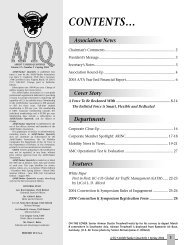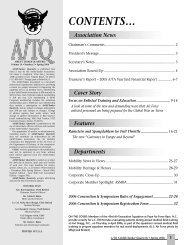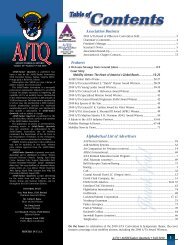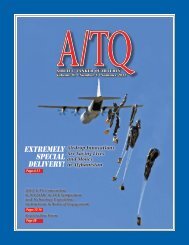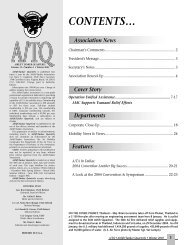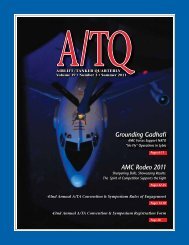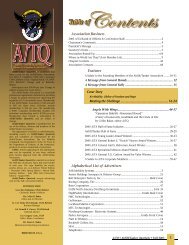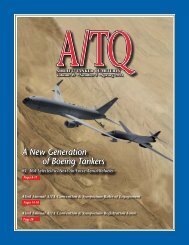1) ATQ Fall 2003 for pdf - Airlift/Tanker Association
1) ATQ Fall 2003 for pdf - Airlift/Tanker Association
1) ATQ Fall 2003 for pdf - Airlift/Tanker Association
Create successful ePaper yourself
Turn your PDF publications into a flip-book with our unique Google optimized e-Paper software.
acting as the “airman in charge of the airfield” until an Air Expeditionary<br />
Group (AEG) or Wing commander arrived to take long-term command of<br />
the operation.<br />
Primary team members also included a field grade operations officer who<br />
would lead the physical survey and deal with air operations issues, a Security<br />
Forces specialist who would work with ground <strong>for</strong>ces to implement airfield<br />
security procedures and coordinate Joint <strong>for</strong>ce protection measures, and<br />
communications specialists responsible <strong>for</strong> establishing and maintaining<br />
all communications. An airfield management specialist and civil engineer<br />
were also required to survey and assess airfield capabilities, including the<br />
dimensions and weight bearing capacities of runways, taxiways and aircraft<br />
parking areas, and to evaluate facilities and supporting infrastructure.<br />
Their duties also included battle damage assessment and the identification<br />
of physical hazards and obstructions to aircraft operations, including<br />
unexploded ordinance. Finally, the team commanders retained the option<br />
to add augmentees as required to support the mission, with the potential to<br />
include specialties such as intelligence, logistics or finance and contracting,<br />
among others.<br />
Teams Identified, Equipped and Trained<br />
In the fall of 2002, the commanders and deputy commanders of the<br />
AMOGs were selected to develop and lead four assessment teams. They<br />
were Colonels Rick Martin and Pete Gray from<br />
the 615 th AMOG at Travis AFB, and Colonels Greg<br />
Cook and A. Ray Myers from the 621 st AMOG at<br />
McGuire AFB. Since the AMOGs already possessed<br />
extensive experience in surveying and establishing<br />
<strong>for</strong>ward air mobility operating locations, it was<br />
clear to AMC planners that the AMOGs were<br />
the units most capable of completing this new<br />
mission. They already possessed AMC airfield<br />
survey teams, and <strong>for</strong> many years, their <strong>Tanker</strong><br />
<strong>Airlift</strong> Control Elements (TALCEs) had already<br />
operated successfully in austere, sometimes<br />
hostile, environments throughout the world.<br />
TALCEs had recently written a new chapter<br />
in AMC operations in Afghanistan, providing<br />
direct support to ground combat operations<br />
and enabling AMC missions under challenging<br />
conditions, including under cover of darkness<br />
through the use of night vision goggles. Most<br />
importantly, AMOG units were highly mobile and<br />
equipped to operate completely independent of<br />
other units, with their own communications, tent<br />
shelters and other equipment items necessary to<br />
sustain their operations.<br />
With potential combat operations looming<br />
in Iraq, everyone felt a great sense of urgency<br />
in fielding this new capability as quickly as<br />
possible. The first challenge <strong>for</strong> AMC and the four commanders was how<br />
to properly train and equip the assessment teams to conduct their mission.<br />
Assessment team members needed to be familiar in the tactics, techniques,<br />
and procedures of the supporting ground <strong>for</strong>ce combat maneuver units,<br />
including the Army, Marines and Special Operations Forces (SOF). Air<br />
Mobility Liaison Officers and Army Ground Liaison Officers assigned to<br />
the AMOGs were tasked to provide this training. AMC then equipped the<br />
teams with a new satellite communications system capable of providing<br />
dependable, secure and non-secure, data and voice communications. Team<br />
members were outfitted with personal tactical and <strong>for</strong>ce protection gear that<br />
mirrored the ground <strong>for</strong>ces they were expected to operate with, including<br />
night vision goggles and night capable weapons. Small tactical vehicles<br />
were purchased to enable greater airfield mobility and allow the teams to be<br />
transported via helicopter when required. Chemical warfare equipment was<br />
standard issue. As they focused on equipping and training their teams, the<br />
commanders also began extensive pre-mission planning and coordination.<br />
Preparations <strong>for</strong> War<br />
With war plans <strong>for</strong> operations in and around Iraq being refined, AMC<br />
assigned the four assessment teams areas of responsibility and identified<br />
the key ground combat units that they were expected to operate alongside.<br />
Colonel Martin’s team was given the Northern sector of Iraq and was<br />
expected to stage from Turkey to work with the 173 rd Airborne Brigade,<br />
while Colonel Myer’s team was assigned the Southern sector, where he<br />
GAT Martin in front of one of the many posters<br />
of Saddam in Southern Iraq.<br />
was aligned with the Army’s V Corp combat units. Colonel Cook’s team<br />
was aligned with SOF units, with anticipated operations in Western Iraq,<br />
and Colonel Gray’s team was to be held in reserve while they continued<br />
to develop and exercise the assessment team concept of operations. Since<br />
these assessment teams were a new and unknown capability, AMC and the<br />
commanders made a concerted ef<strong>for</strong>t to contact their associated units to<br />
develop working relationships with their combat planners and staffs, and<br />
to explain to them assessment team roles and capabilities. This ef<strong>for</strong>t was to<br />
pay great dividends during subsequent combat operations in Iraq.<br />
Now immersed into contingency planning, the teams gathered<br />
imagery and in<strong>for</strong>mation on potential operating airfields in their areas<br />
of responsibility, recognizing that data on airfields in Iraq was dated or<br />
unreliable. All quickly realized that the Iraqis had deliberately sabotaged<br />
most useable runways by obstructing them with discarded military vehicles<br />
and piles of rocks, dirt and other materials. No one knew what lay beneath,<br />
although there was some speculation that the obstructions might also be<br />
booby-trapped with conventional or chemical weapons.<br />
Command and control relationships were also defined, with the<br />
Director of Mobility Forces (DIRMOBFOR) in the CENTCOM Combined Air<br />
Operations Center holding responsibility <strong>for</strong> identifying assessment team<br />
requirements and operating locations, then coordinating their tasking<br />
through AMC’s <strong>Tanker</strong> <strong>Airlift</strong> Control Center at Scott AFB. AMC’s Crisis<br />
Action Team would also be monitoring assessment<br />
team operations to provide reach-back in<strong>for</strong>mation<br />
and support from the command. This was possible<br />
only because of the teams’ secure, dependable<br />
long-range communications capability. The stage<br />
was now set <strong>for</strong> the GATs to be put into action.<br />
February – March <strong>2003</strong>:<br />
The GATS Deploy Forward<br />
GAT Myers was the first to leave home<br />
station, departing McGuire AFB in early February<br />
<strong>2003</strong> bound <strong>for</strong> their staging location in Kuwait.<br />
Upon arrival, they began final coordination and<br />
preparation <strong>for</strong> <strong>for</strong>ward movement with Army<br />
<strong>for</strong>ces into Southeastern Iraq. In the meantime,<br />
they also surveyed the newly constructed Udari<br />
Army Airfield in the Kuwait desert. GAT Martin<br />
deployed to Italy in March to join up with the<br />
173 rd Airborne Brigade, survey Italian airfields<br />
and discuss war plans <strong>for</strong> an Iraqi Northern front.<br />
When Turkey refused to support these plans, and<br />
the strategy in the North changed, GAT Martin<br />
moved to Qatar to prepare <strong>for</strong> operations in<br />
other sectors. GAT Cook also deployed <strong>for</strong>ward<br />
in early March to the Egyptian air base at Cairo<br />
West, where the team spent ten days and helped<br />
establish a USAF tanker Air Expeditionary Group<br />
operation. They then moved to another <strong>for</strong>ward operating location much<br />
closer to Iraq, where they planned and coordinated their anticipated<br />
missions in Iraq with SOF <strong>for</strong>ces. When the war began on March 19 th , the<br />
GATs were postured and ready <strong>for</strong> their mission.<br />
The GATs Go To War<br />
March 22-31:<br />
GAT Myers Opens Tallil Air Base<br />
The first airfield expected to be captured was Tallil in Southeastern Iraq,<br />
and there was a comprehensive plan in place to revive air operations at the<br />
field that had been coordinated between air and ground combat planners<br />
throughout the AOR. GAT Myers played a significant role in those plans. As<br />
the 3 rd Infantry Division (3ID) fought its way towards Tallil, the GAT was<br />
not far behind. Traveling via Army ground convoy, GAT Myers entered Iraq<br />
on March 22, and arrived in Tallil on March 23 just hours after 3ID had<br />
captured the field. In the ensuing days, the team completed its survey of<br />
the field despite ongoing combat operations in the vicinity, coordinated<br />
security and <strong>for</strong>ce protection issues, and helped clear the blocked runways<br />
of obstructions. Finally, they endured the “mother of all dust storms” that<br />
slowed the opening of the field <strong>for</strong> two days. The first C-130 landed on<br />
March 27, carrying with it lead TALCE elements from the 621 AMOG. The<br />
air base was officially open, and its capability to support air operations grew<br />
dramatically with each passing day. A-10 aircraft were operating from the<br />
A/TQ •<strong>Airlift</strong>/<strong>Tanker</strong> Quarterly • <strong>Fall</strong> <strong>2003</strong><br />
27




